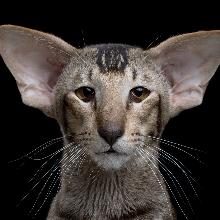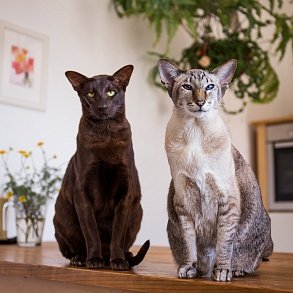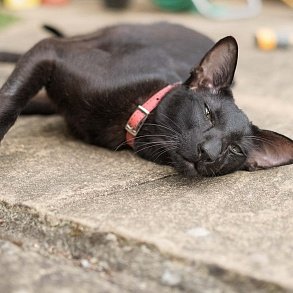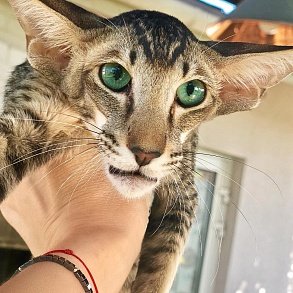Oriental cat

Brief information
- Breed name: Oriental cat
- Country of Origin: USA, UK, Thailand
- Time of origin of the breed: XIX century
- Weight: 3 – 8 kg
- Life expectancy: 15 – 20 years
Highlights
- The exotic appearance of the animal is its main trump card. An adult oriental cat somewhat resembles an alien alien who mistakenly teleported to our planet and is trying to establish contact with its inhabitants.
- Favorite place of orientals is next to the owner. They follow their own owner like a shadow and are ready to entertain him with a good-natured purr at any moment.
- There is a small "energy reactor" hidden inside each oriental cat. Usually a pet throws out an excess of emotions in active games, although walking in the fresh air will not be superfluous for him either.
- Adults are very talkative and like to attract attention by persistent meowing.
- Cats of the oriental breed are often called "rainbow pets", since among the representatives of this clan there are about 300 variants of colors.
- Oriental earwigs are friendly enough and will calmly accept the neighborhood with other pets, including dogs.
- The breed is not intended for too busy owners. An oriental left alone will suffer from a lack of communication, which will negatively affect his nervous system.
- For those who dream of a dog, but cannot afford its maintenance yet, experts recommend getting an oriental. His habits are very similar to those of a dog, not to mention the enthusiastic reverence of the owner, in which the big-eared "energizer" will surpass any barbosa.
Oriental Cats - intellectuals, athletes and, finally, just beauties, charming with their unique grace and sophistication of the silhouette. Possessing a playful nature and developed intuition, these green-eyed "Asians" easily enter into trust and are able to fall in love with even the most desperate cat-hater. The owner in the eyes of the animal is the supreme being to whom the pet is obliged to prove his love and devotion around the clock. In exchange for their affection, orientals expect no less generosity from the owner. Respect, give maximum time and attention, provide your own knees for personal use so that you can lie on them in plenty – all this oriental pussies hope to receive from any person whose house they have made happy with their stay.
Breed characteristics
History of the Oriental cat breed
Genetically oriental cats are close to siam , together with which they were exported from Thailand in the XIX century. British breeders did not consider (or did not want to consider) an independent breed in green-eyed cats, therefore they ranked them among the tribe of classic Siamese with a modified type of color. It is worth noting that orientals were not particularly favored at European exhibitions, systematically disqualifying mustachioed emigrants for non-standard colors, then for the emerald shade of the iris.
The animals also did not arouse much interest among potential owners, so up until the beginning of the XX century, oriental cats were bred only by enthusiastic breeding enthusiasts. The real crisis fell on Thai earwigs in 1923, after the American Siamese Cat Club strictly tabooed breeding of any varieties of pets, with the exception of blue-eyed individuals with a Himalayan color.
Orientals have been in limbo for almost 30+ years: they were excluded from the Siamese clan, but they were not recognized as an independent breed. It was only in the 60s that British and American breeders, who became interested in the extremalization of the appearance of animals, remembered about the cats. Initially, the breeders planned to bring out another variety of Siamese cat, which would have a uniform coat color, but would not lose the elegance of the lines. To achieve this goal, Orientals began to cross with abyssinian and other shorthair breeds.
1977 is a landmark year for orientals, in which the wards of American breeders received their own standard of appearance. By the way, the first set of breed characteristics developed for overseas muroks was almost completely copied from the Siamese standard (with the exception of the items "body" and "colors"). But in Britain, Asian cats were not in a hurry to be honored and for a long 20 years they looked closely at them, scrupulously weighing all the pros and cons. As a result, English earwigs were able to become an independent breed only in 1997, after the official recognition of the GCCF.
Video: Oriental Cat
Appearance of an oriental cat
Orientals are typical Asians: graceful, lean, with the hypnotic power of a jade gaze. A distinctive feature of these charismatic cats is the phenomenal plasticity of movements, thanks to which even the usual stretching in their performance turns into a full–fledged yoga master class. According to the type of wool, oriental cats are divided into short- and long-haired. The last variety was born in the 60s of the last century as a result of crossing the shorthair oriental with Balinese ( balinese cat ). As an independent breed, the Oriental Longhair was introduced in 1977, but it was only in 1997 that it was able to confirm its viability at exhibition competitions.
Head
According to the standard approved by the WCF (World Cat Federation), the oriental's head should have a flat forehead and a raised profile. The muzzle of representatives of this breed should be narrow, and the chin line clearly outlined. A mandatory item is the wedge–shaped shape of the skull.
Nose
Elongated, smooth. It is located approximately in line with the chin.
Eyes
Almond-shaped, slightly slanted. The distance between the eyes is visually equal to the length of one of them. Regardless of the coat color, all orientals have a rich emerald shade of eyes. An exception to the general rule is considered to be white-haired individuals whose iris color may be blue. Some muroks have heterochromia (mismatch).
Ears
They are quite massive in relation to the head. The ear cloth is thin and wide, continuing the wedge-shaped line of the cat's muzzle. The tip is slightly rounded. The most intensive growth of the auricles is observed in the first months of the animal's life, which is why the oriental kitten resembles a hybrid of Cheburashka and Yoda from Star Wars.
Neck
Graceful, elongated type.
Torso
Slender, noticeably elongated, with a well-developed muscular corset. The constitution of the trunk is close to lean: the animals look exquisitely graceful.
Limbs
Oriental cats have extremely long limbs, giving their silhouette a slight aristocracy and grace. The paws of the animals are oval and relatively small.
Tail
Whip-like, very long, with a sharp tip. The thickness of the tail is the same along the entire length.
Wool
Oriental cats have practically no undercoat, thanks to which the wool gently outlines the contours of the body. The hair of short-haired individuals is shiny, satin-like. Long-haired animals have fine, silky hair. Since the representatives of the second type of hair fits snugly to the body, its real length is partially "lost".
Color
What the tribal experts treated as loyally as possible is the color options of orientals. Today it is one of the few cat breeds that has the right to almost any shades from all existing ones.
In order to systematize the "colors" of eared cats, felinological associations have identified their basic types. In particular, modern oriental cats can have "fur coats" of such colors as:
- purple (lavender);
- blue;
- red;
- havana (brown);
- cinnamon (cinnamon);
- fawn (beige);
- ebony (black);
- cream;
- white.
Of tabby colors, marble, brindle, ticked and spotted variants are preferred.
Defects and disqualifying defects of the breed
Serious defects that spoil the aristocratic appearance of oriental cats include strabismus, any shade of the iris, except green, as well as protruding and clearly palpable cartilage in the sternum. As for exhibition events, polydacts, very small or too thin individuals and cats with tail fractures will not be allowed to attend them in the first place. The list of defective pets includes animals with insufficiently strong hind legs, spots on the coat in the form of medallions, as well as cats breathing through their mouths. In the long-haired variety of orientals, a double coat with a well-developed undercoat can become a reason for disqualification.
Photos of oriental cats
Character of an oriental cat
If buying a baby oriental cat, you expect to get a haughty sofa Buddha in the future, do not hope – the Asian mentality in these cats sleeps soundly. Purebred orientals are quite contact and playful pets, madly in love with their own owner. Eastern arrogance and detachment are absolutely not characteristic of them.
Oriental cats are characterized by dog-like behavior. This means that wherever the owner goes, the "wool Yods" will necessarily be attached to the side to control his every step. Take into account the fact that you will only dream of peace with these perpetual motion machines, jumpers and runners. Sofas for oriental cats are not a habitat, but a convenient springboard from which it is so convenient to "take off" on a wardrobe, chest of drawers or cornice. The conquest of heights, to which the cats so selflessly give themselves, brings with it inevitable destruction in the interior, therefore, if a vase broken by a pet can seriously spoil your mood, it is better not to start an oriental murka.
Oriental cats are inveterate gamblers, and this addiction is not treated, so buy your pet more clockwork mice, teasers and balls – let him have fun at his own pleasure. With age, orientals do not lose interest in games, so even elderly individuals are happy to chase wrappers and paper balls on the floor. Another characteristic feature of the breed is a burning curiosity. Secrets, no matter how insignificant they may be, oriental cats simply cannot stand. The contents of any closed container are subject to thorough inspection, and slammed doors to another room are regarded as a military secret that must be disclosed at all costs.
Oriental cats are very dependent on human attention. They endure loneliness with difficulty, so before buying a Thai earwig, it is worth thinking thoroughly about who will stay with the pet while you are at work. As for the annoying meowing, which many owners of orientals complain about, it really does take place, so the "talkativeness" of the breed will have to be taken for granted. But the timbre of the voice of these cats is more pleasant than that of the same Siamese.
Most oriental cats have a bright personality. For example, some individuals are not very disposed to children, while others, on the contrary, treat the younger generation with great condescension. Orientals get along well with other cats. But dogs may feel a slight distrust, which eventually passes. According to experts, the green-eyed "Asian" should not be the only pet in the house, because the presence of other animals in the room helps him to endure separation from the owner less painfully.
Training and education
Orientals inherited a lively, sharp mind and excellent learning abilities from their Thai ancestors. In particular, kotofey is easy to "train" for aportirovka objects, as well as for the execution of simple commands. As for the basics of etiquette, their pet will have to be vaccinated, because, despite a fairly high level of intelligence, oriental cats are capable of minor dirty tricks. For example, little earwigs love to swing on curtains and dig in flower pots. They do this not out of harmfulness, but out of thoughtlessness, so it is very important to immediately point out to the kitten that such behavior is unacceptable.
Punishing, and even more so beating an animal is the last thing. An oriental cat easily guesses about its own mistakes, relying only on the intonation of your voice, so use this quality to its full capacity. Strictly shout at the mustachioed limitless man walking around the table and expressively hiss at the kitten climbing the curtains. You can be sure that the pet will intuitively understand what is wanted from him.
A common mistake that can negate the results of all your efforts is periodic exceptions to the established rules. As an example: today a serious suggestion was made to a kitten jumping on the table, and tomorrow you are shooting a video for YouTube, where a tiny Cheburashka is briskly climbing the tablecloth under your encouraging comments.
Maintenance and care
Oriental cats do not require any special and time-consuming care. Thai earwigs prefer to monitor the purity of their fur themselves, which, by the way, they manage quite well. The owner only has to buy a rubber mitten to clean the falling hairs from the pet's body during seasonal molting. The same procedure can be carried out with the help of an ordinary wet cloth: shedding wool easily sticks to wet matter. Bathing orientals is not recommended in principle. An exception can be made except for an animal that is too dirty or for individuals preparing for an exhibition.
No more than once a week, cats' ears are cleaned. No special devices other than a cotton swab and a disinfectant lotion, which will just as well replace ordinary vaseline, will be required for this procedure. Regularly inspect the pet's eyes, removing accumulated dirt and mucus with a cotton pad soaked in boiled water. Ideally, oriental cats should also brush their teeth, but in practice few owners want to participate in this painstaking process. If you are unable to process the oral cavity of your pet for some reason, try to minimize the risk of plaque and tartar by buying dry food. Tightly pressed "drying" croquettes do a good job with the function of brushing teeth and are quite capable of replacing an ordinary brush. Animals that eat wet canned food can buy special veterinary treats from plaque (sausages and bones for dogs are suitable).
Care for the claws of an oriental cat begins with the purchase of a scratching post. But since the claw plate of representatives of this breed grows quite intensively, once a month they should arrange a "pedicure" session. Shorten the claw by no more than 2 mm, otherwise there is a risk of injuring the pet's skin. If the cat actively resists in the process, it is better to involve an assistant in the case and stretch the "pleasure" for several days.
Orientals have one not very pleasant trait – they love to taste indoor flowers. If a green-eyed kitten of this breed has appeared in your house, diffenbachia, azaleas and other plants poisonous to cats should be removed from his field of vision. The same applies to open windows. To fall out of them for a gutta–percha "Asian" is a matter of a few seconds.
Feeding
It will not be possible to save money on buying industrial feed with oriental: the digestive system of the lop-eared "Thais" is simply unable to digest the products from your table normally. So in the case of nutrition, the owner of an oriental cat has only two options: treat the pet with wet canned food or transfer it to "drying". By the way, cats themselves prefer the first option, while their owners are more focused on dry food, which is both cheaper and stored longer. If you want to please your own murka, but not to the detriment of your own comfort, try alternating canned food and "drying". The only thing you should not do is to mix both types of food in one feeding.
Sometimes the earwigs can be pampered with natural products, for example, a piece of lean meat, fish fillet, oatmeal porridge with milk. But too often such belly holidays should not be arranged. Firstly, the pet will quickly get used to the goodies, which is fraught with a loss of interest in industrial feed. Secondly, such gluttony leads to obesity, to which orientals are already prone. The daily menu of the kotofei should not be very diverse, so that the animal is not tempted to eat in reserve. Pick up a premium type of food suitable for a mustachioed friend (options for Siamese cats are suitable) and do not deviate from the set course.
On a note: it is possible to determine how suitable this or that kind of food is for a cat by the condition of its fur. A soft, glossy, dandruff-free "fur coat" indicates that the diet is selected correctly.
To wean an oriental cat to eat enough for the future, always leave enough food in her bowl. It is undesirable to feed the animal according to the schedule, since pets regard this as a precursor to a serious hunger strike and consume more food than they need.
For the normal functioning of all body systems, it is useful to mix vitamin and mineral complexes in the feed of orientals. In particular, calcium and taurine supplements are shown to young individuals. And of course, do not forget to provide the animal with round-the-clock access to clean water.
Toilet
Orientals are very smart and clean cats. Usually 3-month-old babies from the nursery already know what a tray is and how to use it correctly. If the kitten stubbornly continues to walk past the toilet, it is important to understand that he is not doing this out of harmfulness. The tray may be in the wrong place. For example, if the toilet is located in the bathroom, the animal may be irritated by the smell of household chemicals.
It is better if the tray will stand in a secluded corner where no one will see the baby and where he can really relax. A kitten sitting down to relieve itself in the wrong place needs to be scared, but it should be done so that the animal does not understand that the source of the threat is the owner. For example, you can clap your hands loudly, spray an oriental cat with water from a spray bottle or throw some soft toy at her.
Health and diseases of oriental cats
Despite the fact that the average life expectancy of Orientals is 15-17 years, you can't call them real big guys. By inheritance from Siamese ancestors, a whole set of genetic ailments has passed to the cats, which significantly complicate their lives. Many individuals are diagnosed with liver amyloidosis, which, in the absence of timely treatment, can cause liver failure. Another scourge of the breed is myocardial diseases (dilated cardiomyopathy), so at least once every six months the animal must undergo ultrasound diagnostics.
Eye problems among oriental cats are also quite common. Most often, "Thais" suffer from strabismus and progressive retinal atrophy. In addition, there is always a risk of kittens being born with flat chest syndrome. If the disease is not recognized and treated in time, the baby's lungs will not be able to work at full capacity, and he will simply suffocate.
How to choose a kitten
When buying an oriental breed kitten, be sure to ask about its age. Nurseries that value their own reputation do not sell animals that are under 3 months old. Assessing the conditions of keeping babies, pay attention to the presence of cages in which unscrupulous sellers often lock their wards. Experienced specialists who love their work have kittens brought up at home: they are played with, they are not put in an aviary and they are not restricted in communicating with other pets. Accordingly, such individuals will be socialized faster.
To assess the health of an oriental kitten, its appearance will also help. Earwigs with matted fur, discharge from the eyes and nose and bloated bellies will not bring anything but problems. Any kitten purchased in a kennel must have a metric or pedigree. If there are none, then, most likely, under the guise of a purebred oriental, they are trying to hand you a half-breed. Sometimes breeders explain the lack of documents for a kitten by unplanned mating, although this is nothing more than excuses and attempts to conceal the truth about the true origin of the animal.
Those who plan to knit their pet in the future and receive offspring from him should look into kennels where oriental breed-class cats with impressive pedigrees are sold. If you do not intend to breed kittens for sale, visit places where orientals are engaged without the right of breeding. Most of these nurseries offer already neutered or sterilized kittens.
Some breeders have a negative attitude to early sterilization, which can seriously affect the external parameters of the cat, and do not carry out this procedure. In this case, all responsibility for the reproductive function of the pet falls on the future owner. Usually, before the sale, the buyer signs a contract, according to which he undertakes to sterilize / neuter the kitten as soon as he turns 8-12 months old.
Photos of oriental kittens
How much does an oriental cat cost
The cost of oriental kittens is affected by their class, as well as the color of the coat. A pet-class chocolate baby in most domestic nurseries can be bought for $250 - $300. The same kitten, but already in shades of fawn and cinnamon will cost in $450 - $600. The most expensive are the individuals intended for breeding. The price tag for the future successor of the kind of image-oriented oriental cats can reach $1000.


